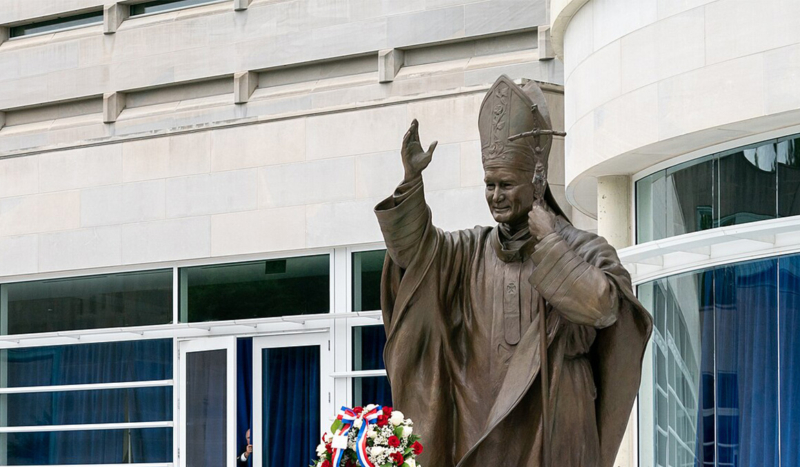
Saint John Paul II National Shrine in Washington, D.C. / The White House / Wikimedia Commons
CV NEWS FEED // A powerful Divine Mercy exhibit will open at the Saint John Paul II National Shrine in Washington, D.C., April 22 and run through Pentecost Sunday, June 8.
“‘The Happiest Day of My Life’: Divine Mercy with St. John Paul II and St. Faustina” is a temporary exhibit featuring a first-class relic of St. Faustina Kowalska available for veneration alongside the shrine’s permanent blood relic of St. John Paul II, according to an emailed press release from the shrine.
Rooted in the spiritual legacy of two saints closely associated with the message of Divine Mercy, the exhibit commemorates the 25th anniversary of both St. Faustina’s canonization and the institution of Divine Mercy Sunday by Pope John Paul II during the Great Jubilee of 2000. It also forms part of the shrine’s celebration of Jubilee Year 2025.
“My joy is truly great in presenting the life and witness of Sr. Faustina Kowalska to the whole Church as a gift of God for our time,” St. John Paul II said in his homily on April 30, 2000, during the canonization of the Polish mystic whom he called “the messenger of the Lord’s merciful love.”
Shrine visitors will encounter panels featuring photos and biographical information about St. Faustina’s early life, her entry into religious life with the Congregation of the Sisters of Our Lady of Mercy, and her role in spreading devotion to Divine Mercy.
The exhibit presents the two core teachings of Divine Mercy — trust in God and mercy toward one’s neighbors — and explores the five principal forms of the devotion: the Divine Mercy image, Divine Mercy Sunday, the chaplet of Divine Mercy, the hour of mercy, and the spreading of the devotion.
The final element discusses both the priesthood as a channel of grace and the role of the laity through the congregation’s Faustinum Association.
Also included are references to the theological writings of Rev. Dr. Ignacy Rózycki, a key figure in the canonization process of St. Faustina, as well as a presentation of the Polish pope’s own teachings on mercy, particularly from his encyclical Dives in Misericordia (Rich in Mercy) and the apostolic exhortation Reconciliatio et Paenitentia (Reconciliation and Penance).
The exhibit title — drawn from words spoken by Pope John Paul II shortly after canonizing St. Faustina — reflects the deep emotional and spiritual significance the Pope placed on Divine Mercy.
“April 30, 2000, was the ‘happiest day’ of John Paul II’s life,” said Sister Donata Farbaniec, local superior of the Sisters of Our Lady of Mercy in Washington, “because the Pope fulfilled the Lord’s ardent desire to institute the Feast of Mercy in the Universal Church.”
Sr. Donata also emphasized the timeliness of this message in today’s world, citing Jesus’ words in St. Faustina’s Diary: “Souls perish in spite of My bitter Passion. I am giving them the last hope of salvation; that is, the Feast of My Mercy.”
The year 2025 also marks several milestones in St. Faustina’s life: 100 years since she entered the Sisters of Our Lady of Mercy (August 1, 1925), 25 years since her canonization (April 30, 2000), and 120 years since her birth in Glogowiec, Poland (August 25, 1905).
In addition to the visual displays and relics, guided tours with the Sisters of Our Lady of Mercy will be available throughout the Easter season.
Anthony Picarello, executive director of the shrine, noted that Divine Mercy is a central theme in St. John Paul II’s life, from his papacy to the circumstances of his death.
“He passed into eternal life on the vigil of Divine Mercy Sunday, April 2, 2005. He was beatified by Pope Benedict XVI on Divine Mercy Sunday of 2011, and canonized by Pope Francis on Divine Mercy Sunday of 2014,” Picarello said.
He added later, “During this Jubilee Year 2025, it is a great privilege for the Shrine to present to our pilgrims the message and meaning of Divine Mercy.”

